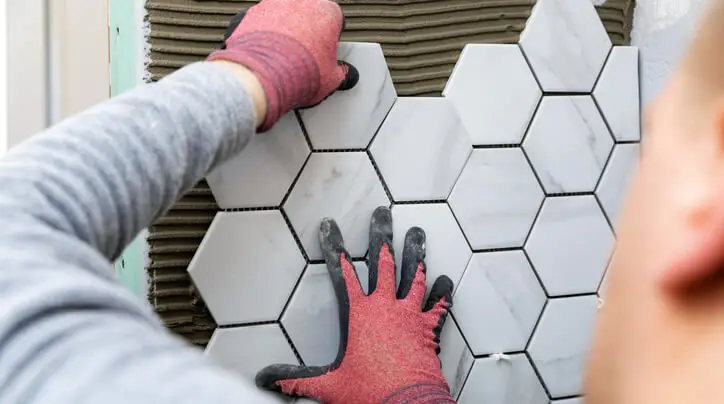
When it comes to flooring, few materials offer the beauty, durability, and versatility of tile. Ideal for kitchens, bathrooms, and even living rooms, tile flooring can withstand heavy foot traffic, moisture, and spills. However, tile installation requires precision, expertise, and the right tools to ensure a lasting finish. In this guide, Skyview Flooring covers everything you need to know about tile installation, from choosing the perfect tile to understanding the installation process.
Why Choose Tile Flooring?
Tile is a popular choice among homeowners for many reasons. It’s not only stylish but also durable and easy to maintain. Here are some of the top benefits of tile flooring:
1. Durability
Tile is incredibly resilient and can last for decades with proper care, making it a long-term investment.
2. Water Resistance
Tile flooring is naturally water-resistant, making it ideal for bathrooms, kitchens, and other high-moisture areas.
3. Easy Maintenance
Tile floors are easy to clean and maintain, as they resist stains, scratches, and spills.
4. Versatile Designs
From ceramic and porcelain to marble and glass, tiles come in countless colors, shapes, and textures, allowing you to create a customized look.
Whether you’re renovating your home or installing floors for the first time, tile is a great option. Skyview Flooring can guide you through the process of choosing and installing tiles that fit your needs and style.
Choosing the Right Tile for Your Space
Not all tiles are created equal. Each type of tile has its characteristics and is suited to different spaces within the home. Here are some common types of tiles and where they work best:
1. Ceramic Tiles
Ceramic tiles are made from clay and are a versatile and affordable choice. They’re ideal for light- to moderate-traffic areas like bathrooms and laundry rooms. While they’re not as durable as porcelain, ceramic tiles come in a wide range of colors and patterns, making them a popular choice for homeowners looking for variety.
2. Porcelain Tiles
Porcelain tiles are denser, more durable, and less porous than ceramic tiles, making them suitable for high-traffic and outdoor areas. They’re resistant to moisture, making them perfect for kitchens, bathrooms, and even patios. Porcelain tiles are also available in a variety of finishes, from matte to high-gloss, giving you options to match your design vision.
3. Natural Stone Tiles
For a luxurious and natural look, natural stone tiles like marble, granite, and slate are excellent choices. They add elegance and sophistication to any space. However, natural stone tiles require more maintenance and should be sealed to protect against stains and water damage. These tiles are best suited for living rooms, foyers, and spaces where you want to create a statement.
4. Glass and Mosaic Tiles
Glass and mosaic tiles are often used as accents or for decorative purposes. They’re perfect for backsplashes and shower walls, where they can add a splash of color and style. Glass tiles are non-porous, easy to clean, and reflect light beautifully, making them an excellent choice for small spaces.
The Tile Installation Process
While tile installation can be a DIY project, professional installation by Skyview Flooring ensures a flawless finish. Here’s a step-by-step overview of the tile installation process:
Step 1: Preparing the Surface
The key to a successful tile installation is preparing a flat, clean, and stable surface. Skyview Flooring’s professionals ensure that the floor is leveled and that any imperfections are addressed. In some cases, a cement backer board is installed to provide a sturdy base, especially in high-moisture areas.
Step 2: Laying Out the Tiles
Once the surface is prepped, the next step is to layout the tiles. This involves finding the center of the room and working outwards to create an even design. The layout process helps determine if any tiles need to be cut to fit around edges and corners.
Step 3: Applying Mortar
Mortar, or thin-set adhesive, is applied to the surface using a notched trowel. It’s important to apply the right amount of mortar to ensure each tile adheres properly. Skyview Flooring’s experts use professional-grade mortar to prevent shifting and cracking over time.
Step 4: Setting the Tiles
Tiles are carefully placed onto the mortar, with spacers added between them to maintain even grout lines. The tiles are gently pressed to ensure full contact with the mortar. At Skyview Flooring, we pay close attention to alignment, ensuring that each tile is level and consistent.
Step 5: Cutting Tiles to Fit
For areas that require smaller tiles or special cuts (like edges and corners), tiles are measured and cut using a wet saw. This step requires precision to ensure a perfect fit without breaking or damaging the tiles.
Step 6: Grouting the Tiles
Once the tiles are set and the mortar has dried, it’s time to apply grout. Grout fills the spaces between tiles, providing a finished look and helping to secure the tiles in place. Skyview Flooring’s professionals carefully choose grout colors that complement the tiles and apply it smoothly, wiping away any excess to ensure clean lines.
Step 7: Sealing the Tiles and Grout
Sealing is the final step and is crucial for natural stone tiles or tiles in moisture-prone areas. A sealant helps protect against stains, water damage, and mold growth. Sealing also makes the tiles easier to clean and maintain in the long run.
Why Choose Professional Tile Installation?
While DIY tile installation may be tempting, professional installation offers numerous advantages. Here’s why you should consider hiring Skyview Flooring:
- Precision and Expertise: Our team has the skills and experience to handle complex tile layouts and intricate designs, ensuring a flawless result.
- Quality Materials: We use high-quality mortar, grout, and tiles to guarantee long-lasting durability and aesthetic appeal.
- Time and Efficiency: Professional installation is faster and more efficient, saving you time and minimizing disruption in your home.
- Warranty and Support: Skyview Flooring offers a warranty on our installation services, giving you peace of mind knowing that your investment is protected.
Tile Maintenance Tips
Tile floors are low-maintenance, but following these simple tips can help extend their lifespan and keep them looking new:
- Regular Cleaning: Sweep or vacuum tile floors regularly to remove dirt and debris that can scratch the surface.
- Mop with Mild Detergent: Use a damp mop with a mild detergent for routine cleaning. Avoid harsh chemicals that could damage the grout or tiles.
- Seal Grout Lines: Grout lines are porous and can absorb stains. Consider sealing them every few years to maintain their appearance.
- Address Spills Immediately: Clean up spills promptly to prevent staining, especially on natural stone tiles.
FAQs
Q1: How long does tile installation typically take?
The duration of tile installation depends on the room’s size and the tile type. Small rooms may take one to two days, while larger projects could take several days. Skyview Flooring provides an estimated timeline based on your specific project.
Q2: Can tiles be installed over existing flooring?
In some cases, tiles can be installed over existing flooring if the current floor is level and in good condition. However, it’s often best to remove old flooring to ensure a solid foundation. Skyview Flooring can assess your current floor and recommend the best approach.
Q3: How often should tile and grout be sealed?
Most tile installations benefit from sealing every 2-3 years, especially in high-moisture areas. Skyview Flooring offers sealing services as part of our maintenance solutions to keep your tile floors looking their best.
